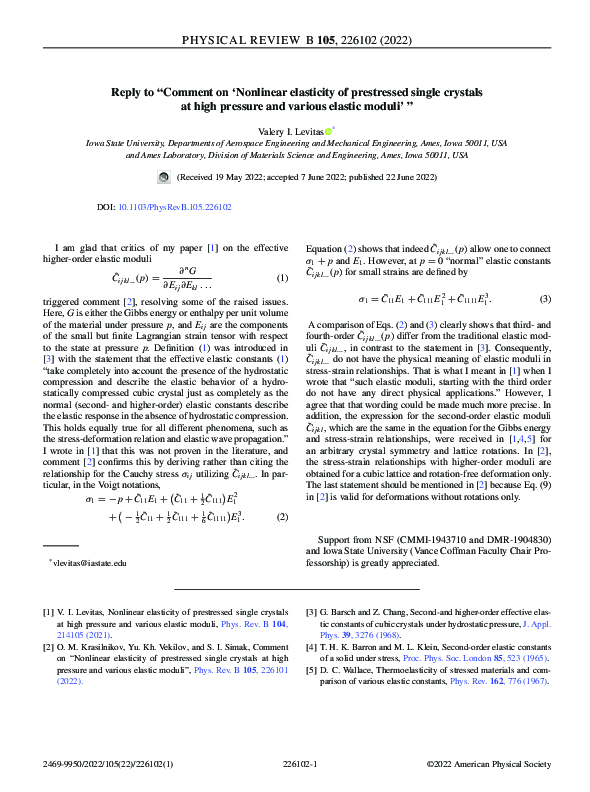Academia.edu no longer supports Internet Explorer.
To browse Academia.edu and the wider internet faster and more securely, please take a few seconds to upgrade your browser.
Reply to “Comment on ‘Nonlinear elasticity of prestressed single crystals at high pressure and various elastic moduli' ”
Reply to “Comment on ‘Nonlinear elasticity of prestressed single crystals at high pressure and various elastic moduli' ”
Physical Review B
Related Papers
Physical Review B
Nonlinear elasticity of prestressed single crystals at high pressure and various elastic moduli2021 •
2010 •
Consider the constitutive law for an isotropic elastic solid with the strain-energy function expanded up to the fourth order in the strain and the stress up to the third order in the strain. The stress–strain relation can then be inverted to give the strain in terms of the stress with a view to considering the incom-pressible limit. For this purpose, use of the logarithmic strain tensor is of particular value. It enables the limiting values of all nine fourth-order elastic constants in the incompressible limit to be evaluated precisely and rigorously. In particular, it is explained why the three constants of fourth-order incom-pressible elasticity l, A, and D are of the same order of magnitude. Several examples of application of the results follow, including determination of the acoustoelastic coefficients in incompressible solids and the limiting values of the coefficients of nonlinearity for elastic wave propagation.
Mathematics and Mechanics of Solids
Second-grade elasticity revisited2018 •
We present a compact, linearized theory for the quasi-static deformation of elastic materials whose stored energy depends on the first two gradients of the displacement (second-grade elastic materials). The theory targets two main issues: (1) the mechanical interpretation of the boundary conditions and (2) the analytical form and physical interpretation of the relevant stress fields in the sense of Cauchy. Since the pioneering works of Toupin and Mindlin et al. in the 1960’s, a major difficulty has been the lack of a convincing mechanical interpretation of the boundary conditions, causing second-grade theories to be viewed as ‘perturbations’ of constitutive laws for simple (first-grade) materials. The first main contribution of this work is the provision of such an interpretation based on the concept of ortho-fiber. This approach enables us to circumvent some difficulties of a well-known ‘reduction’ of second-grade materials to continua with microstructure (in the sense of Mindlin) ...
Advances in Mechanics and Mathematics
Review and Critique of the Stress Gradient Elasticity Theories of Eringen and Aifantis2010 •
Journal of the Mechanics and Physics of Solids
Derivation of higher order gradient continuum theories in 2,3-d non-linear elasticity from periodic lattice models1994 •
Journal of The Mechanics and Physics of Solids
Determination of the overall moduli in second order incompressible elasticity1995 •
The Journal of the Acoustical Society of America
Third- and fourth-order constants of incompressible soft solids and the acousto-elastic effect2010 •
2013 •
2011 •
On the basis of the nonlinear theory of elasticity, the general constitutive equation for an isotropic hyperelastic solid in the presence of initial stress is derived. This derivation involves invariants that couple the deformation with the initial stress and in general, for a compressible material, it requires 10 invariants, reducing to 9 for an incompressible material. Expressions for the Cauchy and nominal stress tensors in a finitely deformed configuration are given along with the elasticity tensor and its specialization to the initially stressed undeformed configuration. The equations governing infinitesimal motions superimposed on a finite deformation are then used to study the combined effects of initial stress and finite deformation on the propagation of homogeneous plane waves in a homogeneously deformed and initially stressed solid of infinite extent. This general framework allows for various different specializations, which make contact with earlier works. In particular, connections with results derived within Biot's classical theory are highlighted. The general results are also specialized to the case of a small initial stress and a small pre-deformation, i.e. to the evaluation of the acoustoelastic effect. Here the formulas derived for the wave speeds cover the case of a second-order elastic solid without initial stress and subject to a uniaxial tension [Hughes and Kelly, Phys. Rev. 92 (1953) 1145] and are consistent with results for an undeformed solid subject to a residual stress [Man and Lu, J. Elasticity 17 (1987) 159]. These formulas provide a basis for acoustic evaluation of the second-and third-order elasticity constants and of the residual stresses. The results are further illustrated in respect of a prototype model of nonlinear elasticity with initial stress, allowing for both finite deformation and nonlinear dependence on the initial stress.
RELATED PAPERS
2017 •
Journal of the International Neuropsychological Society
Increased variability accompanies frontal lobe damage in dementia2002 •
Transplant International
Hemodynamic interaction between portal vien and hepatic artery flow in small-for-size split liver transplantation2002 •
2020 •
Journal of the American Chemical Society
Dissecting Porosity in Molecular Crystals: Influence of Geometry, Hydrogen Bonding, and [π···π] Stacking on the Solid-State Packing of Fluorinated Aromatics2018 •
2012 •
강릉오피✢달림포차〔 DȺLPØCHȺ 6ㆍCØM 〕강릉오피
강릉오피✢달림포차〔 DȺLPØCHȺ 6ㆍCØM 〕강릉오피㉻강릉오피✢강릉오피 강릉오피2022 •

 Valery Levitas
Valery Levitas